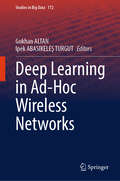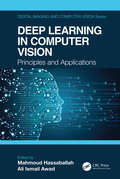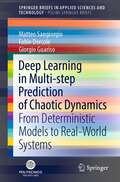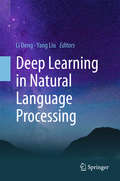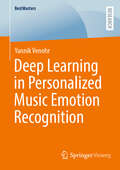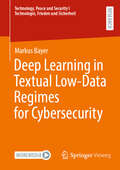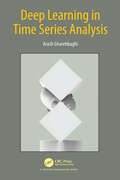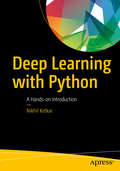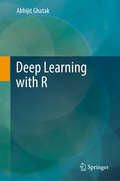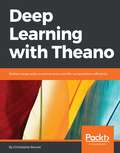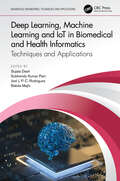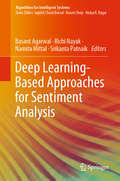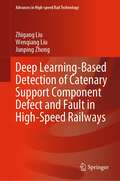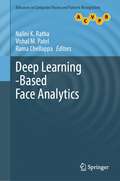- Table View
- List View
Deep Learning in Ad-Hoc Wireless Networks (Studies in Big Data #172)
by Gokhan Altan Ipek Abasikeleş TurgutThis book presents innovative applications of deep learning techniques in wireless ad-hoc networks, addressing critical challenges such as trust, routing, traffic management, and intrusion detection. By combining advanced AI models with real-world network scenarios, the chapters explore novel solutions for improving network reliability, security, and efficiency. Readers benefit from a multidisciplinary approach that bridges deep learning and wireless communication, offering both theoretical insights and practical frameworks. Targeting researchers, engineers, and graduate students, this work serves as a valuable resource for understanding and implementing deep learning strategies to optimize modern wireless systems. Whether improving IoT networks, securing controller area networks, or enabling smart mobility, the book provides actionable knowledge on Deep Learning applications for solving current and future challenges in ad-hoc wireless networks.
Deep Learning in Computer Vision: Principles and Applications (Digital Imaging and Computer Vision)
by Ali Ismail Awad Mahmoud HassaballahDeep learning algorithms have brought a revolution to the computer vision community by introducing non-traditional and efficient solutions to several image-related problems that had long remained unsolved or partially addressed. This book presents a collection of eleven chapters where each individual chapter explains the deep learning principles of a specific topic, introduces reviews of up-to-date techniques, and presents research findings to the computer vision community. The book covers a broad scope of topics in deep learning concepts and applications such as accelerating the convolutional neural network inference on field-programmable gate arrays, fire detection in surveillance applications, face recognition, action and activity recognition, semantic segmentation for autonomous driving, aerial imagery registration, robot vision, tumor detection, and skin lesion segmentation as well as skin melanoma classification. The content of this book has been organized such that each chapter can be read independently from the others. The book is a valuable companion for researchers, for postgraduate and possibly senior undergraduate students who are taking an advanced course in related topics, and for those who are interested in deep learning with applications in computer vision, image processing, and pattern recognition.
Deep Learning in Multi-step Prediction of Chaotic Dynamics: From Deterministic Models to Real-World Systems (SpringerBriefs in Applied Sciences and Technology)
by Giorgio Guariso Fabio Dercole Matteo SangiorgioThe book represents the first attempt to systematically deal with the use of deep neural networks to forecast chaotic time series. Differently from most of the current literature, it implements a multi-step approach, i.e., the forecast of an entire interval of future values. This is relevant for many applications, such as model predictive control, that requires predicting the values for the whole receding horizon. Going progressively from deterministic models with different degrees of complexity and chaoticity to noisy systems and then to real-world cases, the book compares the performances of various neural network architectures (feed-forward and recurrent). It also introduces an innovative and powerful approach for training recurrent structures specific for sequence-to-sequence tasks. The book also presents one of the first attempts in the context of environmental time series forecasting of applying transfer-learning techniques such as domain adaptation.
Deep Learning in Natural Language Processing
by Yang Liu Li DengIn recent years, deep learning has fundamentally changed the landscapes of a number of areas in artificial intelligence, including speech, vision, natural language, robotics, and game playing. In particular, the striking success of deep learning in a wide variety of natural language processing (NLP) applications has served as a benchmark for the advances in one of the most important tasks in artificial intelligence. This book reviews the state of the art of deep learning research and its successful applications to major NLP tasks, including speech recognition and understanding, dialogue systems, lexical analysis, parsing, knowledge graphs, machine translation, question answering, sentiment analysis, social computing, and natural language generation from images. Outlining and analyzing various research frontiers of NLP in the deep learning era, it features self-contained, comprehensive chapters written by leading researchers in the field. A glossary of technical terms and commonly used acronyms in the intersection of deep learning and NLP is also provided. The book appeals to advanced undergraduate and graduate students, post-doctoral researchers, lecturers and industrial researchers, as well as anyone interested in deep learning and natural language processing.
Deep Learning in Personalized Music Emotion Recognition (BestMasters)
by Yannik VenohrMusic has a unique power to evoke strong emotions in us—bringing us to tears, lifting us into ecstasy or triggering vivid memories. Often described as a universal language, it conveys feelings that transcend words. But are machines, too, able to understand this language and capture emotions conveyed in music? This book delves into the field of Musical Emotion Recognition (MER), aiming to develop a mathematical model to predict the emotional content of music. It explores the fundamentals of this interdisciplinary research area, including the relationship between music and emotions, mathematical representations of music and deep learning algorithms. Two MER models are developed and evaluated: one employing handcrafted audio features with a long short-term memory architecture and the other using embeddings from the pre-trained music understanding model MERT. Results show that MERT embeddings can enhance predictions compared to traditional handcrafted features. Additionally, driven by the subjectivity of musical emotions and the low inter-rater agreement of annotations, this book investigates personalized emotion recognition. The findings suggest that personalized models surpass the limitations of general MER systems and can even outperform a theoretically perfect general MER system.
Deep Learning in Practice
by Mehdi GhayoumiDeep Learning in Practice helps you learn how to develop and optimize a model for your projects using Deep Learning (DL) methods and architectures. Key features: Demonstrates a quick review on Python, NumPy, and TensorFlow fundamentals. Explains and provides examples of deploying TensorFlow and Keras in several projects. Explains the fundamentals of Artificial Neural Networks (ANNs). Presents several examples and applications of ANNs. Learning the most popular DL algorithms features. Explains and provides examples for the DL algorithms that are presented in this book. Analyzes the DL network’s parameter and hyperparameters. Reviews state-of-the-art DL examples. Necessary and main steps for DL modeling. Implements a Virtual Assistant Robot (VAR) using DL methods. Necessary and fundamental information to choose a proper DL algorithm. Gives instructions to learn how to optimize your DL model IN PRACTICE. This book is useful for undergraduate and graduate students, as well as practitioners in industry and academia. It will serve as a useful reference for learning deep learning fundamentals and implementing a deep learning model for any project, step by step.
Deep Learning in Textual Low-Data Regimes for Cybersecurity (Technology, Peace and Security I Technologie, Frieden und Sicherheit)
by Markus BayerIn today's fast-paced cybersecurity landscape, professionals are increasingly challenged by the vast volumes of cyber threat data, making it difficult to identify and mitigate threats effectively. Traditional clustering methods help in broadly categorizing threats but fall short when it comes to the fine-grained analysis necessary for precise threat management. Supervised machine learning offers a potential solution, but the rapidly changing nature of cyber threats renders static models ineffective and the creation of new models too labor-intensive. This book addresses these challenges by introducing innovative low-data regime methods that enhance the machine learning process with minimal labeled data. The proposed approach spans four key stages:Data Acquisition: Leveraging active learning with advanced models like GPT-4 to optimize data labeling.Preprocessing: Utilizing GPT-2 and GPT-3 for data augmentation to enrich and diversify datasets.Model Selection: Developing a specialized cybersecurity language model and using multi-level transfer learning.Prediction: Introducing a novel adversarial example generation method, grounded in explainable AI, to improve model accuracy and resilience.
Deep Learning in Time Series Analysis
by Arash GharehbaghiDeep learning is an important element of artificial intelligence, especially in applications such as image classification in which various architectures of neural network, e.g., convolutional neural networks, have yielded reliable results. This book introduces deep learning for time series analysis, particularly for cyclic time series. It elaborates on the methods employed for time series analysis at the deep level of their architectures. Cyclic time series usually have special traits that can be employed for better classification performance. These are addressed in the book. Processing cyclic time series is also covered herein. An important factor in classifying stochastic time series is the structural risk associated with the architecture of classification methods. The book addresses and formulates structural risk, and the learning capacity defined for a classification method. These formulations and the mathematical derivations will help the researchers in understanding the methods and even express their methodologies in an objective mathematical way. The book has been designed as a self-learning textbook for the readers with different backgrounds and understanding levels of machine learning, including students, engineers, researchers, and scientists of this domain. The numerous informative illustrations presented by the book will lead the readers to a deep level of understanding about the deep learning methods for time series analysis.
Deep Learning with Python
by Nikhil KetkarDiscover the practical aspects of implementing deep-learning solutions using the rich Python ecosystem. This book bridges the gap between the academic state-of-the-art and the industry state-of-the-practice by introducing you to deep learning frameworks such as Keras, Theano, and Caffe. The practicalities of these frameworks is often acquired by practitioners by reading source code, manuals, and posting questions on community forums, which tends to be a slow and a painful process. Deep Learning with Python allows you to ramp up to such practical know-how in a short period of time and focus more on the domain, models, and algorithms.This book briefly covers the mathematical prerequisites and fundamentals of deep learning, making this book a good starting point for software developers who want to get started in deep learning. A brief survey of deep learning architectures is also included.Deep Learning with Python also introduces you to key concepts of automatic differentiation and GPU computation which, while not central to deep learning, are critical when it comes to conducting large scale experiments. What You Will Learn Leverage deep learning frameworks in Python namely, Keras, Theano, and Caffe Gain the fundamentals of deep learning with mathematical prerequisites Discover the practical considerations of large scale experiments Take deep learning models to productionWho This Book Is ForSoftware developers who want to try out deep learning as a practical solution to a particular problem. Software developers in a data science team who want to take deep learning models developed by data scientists to production.
Deep Learning with R
by Abhijit GhatakDeep Learning with R introduces deep learning and neural networks using the R programming language. The book builds on the understanding of the theoretical and mathematical constructs and enables the reader to create applications on computer vision, natural language processing and transfer learning. The book starts with an introduction to machine learning and moves on to describe the basic architecture, different activation functions, forward propagation, cross-entropy loss and backward propagation of a simple neural network. It goes on to create different code segments to construct deep neural networks. It discusses in detail the initialization of network parameters, optimization techniques, and some of the common issues surrounding neural networks such as dealing with NaNs and the vanishing/exploding gradient problem. Advanced variants of multilayered perceptrons namely, convolutional neural networks and sequence models are explained, followed by application to different use cases. The book makes extensive use of the Keras and TensorFlow frameworks.
Deep Learning with Theano
by Christopher BourezDevelop deep neural networks in Theano with practical code examples for image classification, machine translation, reinforcement agents, or generative models. About This Book • Learn Theano basics and evaluate your mathematical expressions faster and in an efficient manner • Learn the design patterns of deep neural architectures to build efficient and powerful networks on your datasets • Apply your knowledge to concrete fields such as image classification, object detection, chatbots, machine translation, reinforcement agents, or generative models. Who This Book Is For This book is indented to provide a full overview of deep learning. From the beginner in deep learning and artificial intelligence, to the data scientist who wants to become familiar with Theano and its supporting libraries, or have an extended understanding of deep neural nets. Some basic skills in Python programming and computer science will help, as well as skills in elementary algebra and calculus. What You Will Learn • Get familiar with Theano and deep learning • Provide examples in supervised, unsupervised, generative, or reinforcement learning. • Discover the main principles for designing efficient deep learning nets: convolutions, residual connections, and recurrent connections. • Use Theano on real-world computer vision datasets, such as for digit classification and image classification. • Extend the use of Theano to natural language processing tasks, for chatbots or machine translation • Cover artificial intelligence-driven strategies to enable a robot to solve games or learn from an environment • Generate synthetic data that looks real with generative modeling • Become familiar with Lasagne and Keras, two frameworks built on top of Theano In Detail This book offers a complete overview of Deep Learning with Theano, a Python-based library that makes optimizing numerical expressions and deep learning models easy on CPU or GPU. The book provides some practical code examples that help the beginner understand how easy it is to build complex neural networks, while more experimented data scientists will appreciate the reach of the book, addressing supervised and unsupervised learning, generative models, reinforcement learning in the fields of image recognition, natural language processing, or game strategy. The book also discusses image recognition tasks that range from simple digit recognition, image classification, object localization, image segmentation, to image captioning. Natural language processing examples include text generation, chatbots, machine translation, and question answering. The last example deals with generating random data that looks real and solving games such as in the Open-AI gym. At the end, this book sums up the best -performing nets for each task. While early research results were based on deep stacks of neural layers, in particular, convolutional layers, the book presents the principles that improved the efficiency of these architectures, in order to help the reader build new custom nets. Style and approach It is an easy-to-follow example book that teaches you how to perform fast, efficient computations in Python. Starting with the very basics-NumPy, installing Theano, this book will take you to the smooth journey of implementing Theano for advanced computations for machine learning and deep learning.
Deep Learning, Machine Learning and IoT in Biomedical and Health Informatics: Techniques and Applications (Biomedical Engineering)
by Sujata Dash Joel J. P. C. Rodrigues Subhendu Kumar Pani Babita MajhiBiomedical and Health Informatics is an important field that brings tremendous opportunities and helps address challenges due to an abundance of available biomedical data. This book examines and demonstrates state-of-the-art approaches for IoT and Machine Learning based biomedical and health related applications. This book aims to provide computational methods for accumulating, updating and changing knowledge in intelligent systems and particularly learning mechanisms that help us to induce knowledge from the data. It is helpful in cases where direct algorithmic solutions are unavailable, there is lack of formal models, or the knowledge about the application domain is inadequately defined. In the future IoT has the impending capability to change the way we work and live. These computing methods also play a significant role in design and optimization in diverse engineering disciplines. With the influence and the development of the IoT concept, the need for AI (artificial intelligence) techniques has become more significant than ever. The aim of these techniques is to accept imprecision, uncertainties and approximations to get a rapid solution. However, recent advancements in representation of intelligent IoTsystems generate a more intelligent and robust system providing a human interpretable, low-cost, and approximate solution. Intelligent IoT systems have demonstrated great performance to a variety of areas including big data analytics, time series, biomedical and health informatics. This book will be very beneficial for the new researchers and practitioners working in the biomedical and healthcare fields to quickly know the best performing methods. It will also be suitable for a wide range of readers who may not be scientists but who are also interested in the practice of such areas as medical image retrieval, brain image segmentation, among others. • Discusses deep learning, IoT, machine learning, and biomedical data analysis with broad coverage of basic scientific applications • Presents deep learning and the tremendous improvement in accuracy, robustness, and cross- language generalizability it has over conventional approaches • Discusses various techniques of IoT systems for healthcare data analytics • Provides state-of-the-art methods of deep learning, machine learning and IoT in biomedical and health informatics • Focuses more on the application of algorithms in various real life biomedical and engineering problems
Deep Learning-Based Approaches for Sentiment Analysis (Algorithms for Intelligent Systems)
by Basant Agarwal Namita Mittal Srikanta Patnaik Richi NayakThis book covers deep-learning-based approaches for sentiment analysis, a relatively new, but fast-growing research area, which has significantly changed in the past few years. The book presents a collection of state-of-the-art approaches, focusing on the best-performing, cutting-edge solutions for the most common and difficult challenges faced in sentiment analysis research. Providing detailed explanations of the methodologies, the book is a valuable resource for researchers as well as newcomers to the field.
Deep Learning-Based Detection of Catenary Support Component Defect and Fault in High-Speed Railways (Advances in High-speed Rail Technology)
by Zhigang Liu Wenqiang Liu Junping ZhongThis book focuses on the deep learning technologies and their applications in the catenary detection of high-speed railways. As the only source of power for high-speed trains, the catenary's service performance directly affects the safe operation of high-speed railways. This book systematically shows the latest research results of catenary detection in high-speed railways, especially the detection of catenary support component defect and fault. Some methods or algorithms have been adopted in practical engineering. These methods or algorithms provide important references and help the researcher, scholar, and engineer on pantograph and catenary technology in high-speed railways. Unlike traditional detection methods of catenary support component based on image processing, some advanced methods in the deep learning field, including convolutional neural network, reinforcement learning, generative adversarial network, etc., are adopted and improved in this book. The main contents include the overview of catenary detection of electrified railways, the introduction of some advance of deep learning theories, catenary support components and their characteristics in high-speed railways, the image reprocessing of catenary support components, the positioning of catenary support components, the detection of defect and fault, the detection based on 3D point cloud, etc.
Deep Learning-Based Face Analytics (Advances in Computer Vision and Pattern Recognition)
by Vishal M. Patel Rama Chellappa Nalini K. RathaThis book provides an overview of different deep learning-based methods for face recognition and related problems. Specifically, the authors present methods based on autoencoders, restricted Boltzmann machines, and deep convolutional neural networks for face detection, localization, tracking, recognition, etc. The authors also discuss merits and drawbacks of available approaches and identifies promising avenues of research in this rapidly evolving field. Even though there have been a number of different approaches proposed in the literature for face recognition based on deep learning methods, there is not a single book available in the literature that gives a complete overview of these methods. The proposed book captures the state of the art in face recognition using various deep learning methods, and it covers a variety of different topics related to face recognition. This book is aimed at graduate students studying electrical engineering and/or computer science. Biometrics is a course that is widely offered at both undergraduate and graduate levels at many institutions around the world: This book can be used as a textbook for teaching topics related to face recognition. In addition, the work is beneficial to practitioners in industry who are working on biometrics-related problems. The prerequisites for optimal use are the basic knowledge of pattern recognition, machine learning, probability theory, and linear algebra.
Deep Learning-Based Forward Modeling and Inversion Techniques for Computational Physics Problems
by Qiang Ren Yinpeng WangThis book investigates in detail the emerging deep learning (DL) technique in computational physics, assessing its promising potential to substitute conventional numerical solvers for calculating the fields in real-time. After good training, the proposed architecture can resolve both the forward computing and the inverse retrieve problems.Pursuing a holistic perspective, the book includes the following areas. The first chapter discusses the basic DL frameworks. Then, the steady heat conduction problem is solved by the classical U-net in Chapter 2, involving both the passive and active cases. Afterwards, the sophisticated heat flux on a curved surface is reconstructed by the presented Conv-LSTM, exhibiting high accuracy and efficiency. Additionally, a physics-informed DL structure along with a nonlinear mapping module are employed to obtain the space/temperature/time-related thermal conductivity via the transient temperature in Chapter 4. Finally, in Chapter 5, a series of the latest advanced frameworks and the corresponding physics applications are introduced. As deep learning techniques are experiencing vigorous development in computational physics, more people desire related reading materials. This book is intended for graduate students, professional practitioners, and researchers who are interested in DL for computational physics.
Deep Neural Evolution: Deep Learning with Evolutionary Computation (Natural Computing Series)
by Nasimul Noman Hitoshi IbaThis book delivers the state of the art in deep learning (DL) methods hybridized with evolutionary computation (EC). Over the last decade, DL has dramatically reformed many domains: computer vision, speech recognition, healthcare, and automatic game playing, to mention only a few. All DL models, using different architectures and algorithms, utilize multiple processing layers for extracting a hierarchy of abstractions of data. Their remarkable successes notwithstanding, these powerful models are facing many challenges, and this book presents the collaborative efforts by researchers in EC to solve some of the problems in DL. EC comprises optimization techniques that are useful when problems are complex or poorly understood, or insufficient information about the problem domain is available. This family of algorithms has proven effective in solving problems with challenging characteristics such as non-convexity, non-linearity, noise, and irregularity, which dampen the performance of most classic optimization schemes. Furthermore, EC has been extensively and successfully applied in artificial neural network (ANN) research —from parameter estimation to structure optimization. Consequently, EC researchers are enthusiastic about applying their arsenal for the design and optimization of deep neural networks (DNN). This book brings together the recent progress in DL research where the focus is particularly on three sub-domains that integrate EC with DL: (1) EC for hyper-parameter optimization in DNN; (2) EC for DNN architecture design; and (3) Deep neuroevolution. The book also presents interesting applications of DL with EC in real-world problems, e.g., malware classification and object detection. Additionally, it covers recent applications of EC in DL, e.g. generative adversarial networks (GAN) training and adversarial attacks. The book aims to prompt and facilitate the research in DL with EC both in theory and in practice.
Deep Reinforcement Learning with Python: RLHF for Chatbots and Large Language Models
by Nimish SanghiGain a theoretical understanding to the most popular libraries in deep reinforcement learning (deep RL). This new edition focuses on the latest advances in deep RL using a learn-by-coding approach, allowing readers to assimilate and replicate the latest research in this field. New agent environments ranging from games, and robotics to finance are explained to help you try different ways to apply reinforcement learning. A chapter on multi-agent reinforcement learning covers how multiple agents compete, while another chapter focuses on the widely used deep RL algorithm, proximal policy optimization (PPO). You'll see how reinforcement learning with human feedback (RLHF) has been used by chatbots, built using Large Language Models, e.g. ChatGPT to improve conversational capabilities.You'll also review the steps for using the code on multiple cloud systems and deploying models on platforms such as Hugging Face Hub. The code is in Jupyter Notebook, which canbe run on Google Colab, and other similar deep learning cloud platforms, allowing you to tailor the code to your own needs. Whether it’s for applications in gaming, robotics, or Generative AI, Deep Reinforcement Learning with Python will help keep you ahead of the curve.What You'll LearnExplore Python-based RL libraries, including StableBaselines3 and CleanRL Work with diverse RL environments like Gymnasium, Pybullet, and Unity MLUnderstand instruction finetuning of Large Language Models using RLHF and PPOStudy training and optimization techniques using HuggingFace, Weights and Biases, and Optuna Who This Book Is ForSoftware engineers and machine learning developers eager to sharpen their understanding of deep RL and acquire practical skills in implementing RL algorithms fromscratch.
Deep Statistical Comparison for Meta-heuristic Stochastic Optimization Algorithms (Natural Computing Series)
by Peter Korošec Tome EftimovFocusing on comprehensive comparisons of the performance of stochastic optimization algorithms, this book provides an overview of the current approaches used to analyze algorithm performance in a range of common scenarios, while also addressing issues that are often overlooked. In turn, it shows how these issues can be easily avoided by applying the principles that have produced Deep Statistical Comparison and its variants. The focus is on statistical analyses performed using single-objective and multi-objective optimization data. At the end of the book, examples from a recently developed web-service-based e-learning tool (DSCTool) are presented. The tool provides users with all the functionalities needed to make robust statistical comparison analyses in various statistical scenarios.The book is intended for newcomers to the field and experienced researchers alike. For newcomers, it covers the basics of optimization and statistical analysis, familiarizing them with the subject matter before introducing the Deep Statistical Comparison approach. Experienced researchers can quickly move on to the content on new statistical approaches. The book is divided into three parts:Part I: Introduction to optimization, benchmarking, and statistical analysis – Chapters 2-4.Part II: Deep Statistical Comparison of meta-heuristic stochastic optimization algorithms – Chapters 5-7.Part III: Implementation and application of Deep Statistical Comparison – Chapter 8.
Deep in the Swamp
by Brian Lies Donna M. BatemanCount from 1 otter pup to 10 baby crayfish as readers learn about the special relationships of baby and mom mammals, reptiles, birds, and insects that make their home in the Okefenokee Swamp. A helpful guide to swamp flora and fauna is included. Modeled after the song "Over in the Meadow" by Olive A. Wadsworth.
Deeper Learning: A Voice from Laboratory to Classroom (China Perspectives)
by Hang HuIntegrating brain science, cognitive psychology, education and information technology, the books studies how technology promoted deeper learning on mathematics in Chinese primary schools. After introducing the theoretical basis, connotation and mechanism of deeper learning, the author fully explains its practice, including the composition of deeper learning teaching content, the development of digital resources, classroom teaching technology and teachers' professional development of deeper learning. He especially adopts multiple and interdisciplinary research methods, such as deeper learning "triangle evidence" paradigm, learning brain observation, education big data analysis, artificial intelligence education analysis, education action, qualitative and quantitative research. On one hand, the book will give researchers of learning theory and pedagogy an in-depth understanding of what deeper learning is and why it provides a systematic theoretical system; on the other hand, it will also provide school practitioners with operational methods and cases to learn from.
Defect Correction Methods for Fluid Flows at High Reynolds Numbers (Chapman & Hall/CRC Numerical Analysis and Scientific Computing Series)
by Alexander E. LabovskyDefect Correction Methods for Fluid Flows at High Reynold’s Numbers presents the mathematical development of defect correction methods (DCM) in application to fluid flow problems in various settings. We will show several approaches to applying the DCM ideas in computational fluid dynamics (CFD) – from a basic idea of controlling the flow by the means of increased diffusion, to the state-of-the-art family of novel, DCM-based turbulence models. The main idea of the methods presented in this book, is to use defect correction in turbulence modelling; additionally, several methods will also be presented, that aim at reducing the time discretization error.Features · Provides a road map, starting from the ideas of minimally invasive controlling of turbulent flows, to the ways of improving the existing regularization techniques with DCM, to the ideas of ‘full defect correction’ in both space and time and, finally, to the more complex embedding of the DCM into turbulence modelling by the ‘correction’ of the whole turbulence model· Can be used for teaching a topics course on a Masters or Ph.D. level. It is even more suitable as a reference for CFD theorists and practitioners, with most of the methods being minimally invasive and, therefore, easy to implement in the existing/legacy codes· Discusses the current challenges in turbulence modelling with defect correction, showing several possible directions for future developments. Two source codes are provided – one for a regularization technique and another for a novel turbulence model – in order to give an interested researcher a quick start to the topic of DCM in CFD.
Defending Hypatia
by Robert GouldingWhy should mathematics, the purest of sciences, have a history? Medieval mathematicians took little interest in the history of their discipline. Yet in the Renaissance the history of mathematics flourished. This book explores how Renaissance scholars recovered and reconstructed the origins of mathematics by tracing its invention in prehistoric Antiquity, its development by the Greeks, and its transmission to modern Europe via the works of Euclid, Theon and Proclus. The principal architects of this story -- the French philosopher and University of Paris reformer Peter Ramus, and his critic, the young Oxford astronomy lecturer Henry Savile - worked out diametrically opposed models for the development of the mathematical arts, models of historical progress and decline which mirrored each scholar's larger convictions about the nature of mathematical thinking, the purpose of the modern university, and the potential of the human mind. In their hands, the obscure story of mathematical history became a site of contention over some of the most pressing philosophical and pedagogical debates of the sixteenth century.
Defensa del diseño inteligente
by Alejandro SanvisensLa teoría del diseño inteligente considera que la estructura de la materia, del cosmos y de los seres vivos manifiesta un diseño, un proyecto concebido por una inteligencia divina. <P><P>En este libro se dan a conocer los principales indicios de este diseño a través de la complejidad de los seres vivos, del origen de la vida, de la estructura y las leyes de la materia y del desarrollo cósmico. Se defiende la teoría del diseño inteligente de los ataques que ha recibido por parte de los principales representantes del ateísmo contemporáneo.
Defining Enterprise Data and Analytics Strategy: Pragmatic Guidance on Defining Strategy Based on Successful Digital Transformation Experience of Multiple Fortune 500 and Other Global Companies (Management for Professionals)
by Prakash SahThis is the first of its kind book that describes key elements of enterprise data and analytics strategy, and prescribes a pragmatic approach to define the strategy for large enterprises. The book is based on successful digital transformation experience of multiple Fortune 500 and other large enterprises. It is estimated that more than 50% of data and analytics initiatives fail globally because of the inherent complexity of such initiatives. Some of the questions that enterprises struggle with are: How to define enterprise data and analytics strategy? What are the key elements that should be considered while doing so? Why one-size-fits-all approach does not work for all enterprises? How to align data and analytics initiative with the business strategy of the CEO? How to establish a futuristic technology and architecture foundation, given the exponential rate of innovation in data and analytics technologies? How to define the right data and analytics organization model? Why data and analytics organization and processes need to be different from other functions? How to manage organizational change to ensure success of data and analytics initiative? How to define a business value measurement framework and calculate ROI from data and analytics initiative? What are the key skills required in a data and analytics leader to wade through political and other challenges of a large enterprise? This book will help executives, chief digital/analytics officers, data and analytics professionals, and consultants, in answering the above questions. It will help them in addressing various dilemmas that they face every day and making their enterprises data-driven.
